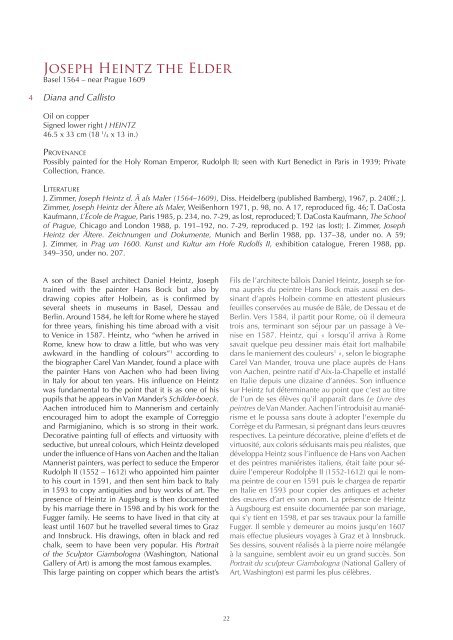XVII - Master Paintings - Jean Luc Baroni and Marty de Cambiaire
Create successful ePaper yourself
Turn your PDF publications into a flip-book with our unique Google optimized e-Paper software.
Joseph Heintz the El<strong>de</strong>r<br />
Basel 1564 – near Prague 1609<br />
4<br />
Diana <strong>and</strong> Callisto<br />
Oil on copper<br />
Signed lower right J HEINTZ<br />
46.5 x 33 cm (18 1 /4 x 13 in.)<br />
Provenance<br />
Possibly painted for the Holy Roman Emperor, Rudolph II; seen with Kurt Benedict in Paris in 1939; Private<br />
Collection, France.<br />
Literature<br />
J. Zimmer, Joseph Heintz d. Ä als Maler (1564–1609), Diss. Hei<strong>de</strong>lberg (published Bamberg), 1967, p. 240ff.; J.<br />
Zimmer, Joseph Heintz <strong>de</strong>r Ältere als Maler, Weißenhorn 1971, p. 98, no. A 17, reproduced fig. 46; T. DaCosta<br />
Kaufmann, L’École <strong>de</strong> Prague, Paris 1985, p. 234, no. 7-29, as lost, reproduced; T. DaCosta Kaufmann, The School<br />
of Prague, Chicago <strong>and</strong> London 1988, p. 191–192, no. 7-29, reproduced p. 192 (as lost); J. Zimmer, Joseph<br />
Heintz <strong>de</strong>r Ältere. Zeichnungen und Dokumente, Munich <strong>and</strong> Berlin 1988, pp. 137–38, un<strong>de</strong>r no. A 59;<br />
J. Zimmer, in Prag um 1600. Kunst und Kultur am Hofe Rudolfs II, exhibition catalogue, Freren 1988, pp.<br />
349–350, un<strong>de</strong>r no. 207.<br />
A son of the Basel architect Daniel Heintz, Joseph<br />
trained with the painter Hans Bock but also by<br />
drawing copies after Holbein, as is confirmed by<br />
several sheets in museums in Basel, Dessau <strong>and</strong><br />
Berlin. Around 1584, he left for Rome where he stayed<br />
for three years, finishing his time abroad with a visit<br />
to Venice in 1587. Heintz, who “when he arrived in<br />
Rome, knew how to draw a little, but who was very<br />
awkward in the h<strong>and</strong>ling of colours” 1 according to<br />
the biographer Carel Van M<strong>and</strong>er, found a place with<br />
the painter Hans von Aachen who had been living<br />
in Italy for about ten years. His influence on Heintz<br />
was fundamental to the point that it is as one of his<br />
pupils that he appears in Van M<strong>and</strong>er’s Schil<strong>de</strong>r-boeck.<br />
Aachen introduced him to Mannerism <strong>and</strong> certainly<br />
encouraged him to adopt the example of Correggio<br />
<strong>and</strong> Parmigianino, which is so strong in their work.<br />
Decorative painting full of effects <strong>and</strong> virtuosity with<br />
seductive, but unreal colours, which Heintz <strong>de</strong>veloped<br />
un<strong>de</strong>r the influence of Hans von Aachen <strong>and</strong> the Italian<br />
Mannerist painters, was perfect to seduce the Emperor<br />
Rudolph II (1552 – 1612) who appointed him painter<br />
to his court in 1591, <strong>and</strong> then sent him back to Italy<br />
in 1593 to copy antiquities <strong>and</strong> buy works of art. The<br />
presence of Heintz in Augsburg is then documented<br />
by his marriage there in 1598 <strong>and</strong> by his work for the<br />
Fugger family. He seems to have lived in that city at<br />
least until 1607 but he travelled several times to Graz<br />
<strong>and</strong> Innsbruck. His drawings, often in black <strong>and</strong> red<br />
chalk, seem to have been very popular. His Portrait<br />
of the Sculptor Giambologna (Washington, National<br />
Gallery of Art) is among the most famous examples.<br />
This large painting on copper which bears the artist’s<br />
Fils <strong>de</strong> l’architecte bâlois Daniel Heintz, Joseph se forma<br />
auprès du peintre Hans Bock mais aussi en <strong>de</strong>ssinant<br />
d’après Holbein comme en attestent plusieurs<br />
feuilles conservées au musée <strong>de</strong> Bâle, <strong>de</strong> Dessau et <strong>de</strong><br />
Berlin. Vers 1584, il partit pour Rome, où il <strong>de</strong>meura<br />
trois ans, terminant son séjour par un passage à Venise<br />
en 1587. Heintz, qui « lorsqu’il arriva à Rome<br />
savait quelque peu <strong>de</strong>ssiner mais était fort malhabile<br />
dans le maniement <strong>de</strong>s couleurs 1 », selon le biographe<br />
Carel Van M<strong>and</strong>er, trouva une place auprès <strong>de</strong> Hans<br />
von Aachen, peintre natif d’Aix-la-Chapelle et installé<br />
en Italie <strong>de</strong>puis une dizaine d’années. Son influence<br />
sur Heintz fut déterminante au point que c’est au titre<br />
<strong>de</strong> l’un <strong>de</strong> ses élèves qu’il apparaît dans Le Livre <strong>de</strong>s<br />
peintres <strong>de</strong> Van M<strong>and</strong>er. Aachen l’introduisit au maniérisme<br />
et le poussa sans doute à adopter l’exemple du<br />
Corrège et du Parmesan, si prégnant dans leurs œuvres<br />
respectives. La peinture décorative, pleine d’effets et <strong>de</strong><br />
virtuosité, aux coloris séduisants mais peu réalistes, que<br />
développa Heintz sous l’influence <strong>de</strong> Hans von Aachen<br />
et <strong>de</strong>s peintres maniéristes italiens, était faite pour séduire<br />
l’empereur Rodolphe II (1552-1612) qui le nomma<br />
peintre <strong>de</strong> cour en 1591 puis le chargea <strong>de</strong> repartir<br />
en Italie en 1593 pour copier <strong>de</strong>s antiques et acheter<br />
<strong>de</strong>s œuvres d’art en son nom. La présence <strong>de</strong> Heintz<br />
à Augsbourg est ensuite documentée par son mariage,<br />
qui s’y tient en 1598, et par ses travaux pour la famille<br />
Fugger. Il semble y <strong>de</strong>meurer au moins jusqu’en 1607<br />
mais effectue plusieurs voyages à Graz et à Innsbruck.<br />
Ses <strong>de</strong>ssins, souvent réalisés à la pierre noire mélangée<br />
à la sanguine, semblent avoir eu un gr<strong>and</strong> succès. Son<br />
Portrait du sculpteur Giambologna (National Gallery of<br />
Art, Washington) est parmi les plus célèbres.<br />
22















